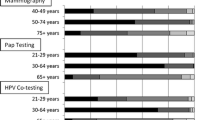Abstract
It is essential for at-risk women to be screened for breast and cervical cancer in a timely manner. Despite a growing interest in the role of health information technology including personal health records (PHRs) to improve quality and outcomes in health care, less is known about the effectiveness of PHRs to promote breast and cervical cancer screening among women with a family history of cancer (FHC). We examined the association between access to PHRs and the use of a recommended mammography and a Pap smear testing among women with a FHC using data from the 2015 Health Information National Trends Survey (HINTS 4-cycle 4) and the 2016 Area Health Resource Files. The study sample was comprised of 1250 women aged 20–75 years with a FHC, a subsample of 3677 survey respondents. Of the 1250 women, 64.96% received a mammogram, and 75.44% underwent a Pap testing. Among women with a FHC, there was a significant and positive association between access to PHRs and the receipt of a mammogram (adjusted odds ratio (aOR) 4.20; 95% CI, 2.23–7.94; p < .001) and a Pap testing (aOR 3.13; 95% CI, 1.56–6.28; p < .01). Our findings suggest that at-risk women can benefit from greater access to PHRs. Policymakers should consider incentivizing providers and healthcare organizations who provide access to PHRs to their patients as well as developing programs that can help improve access to PHRs among at-risk women.
Similar content being viewed by others
References
World Health Organization (2018) Breast cancer. http://who.int/cancer/prevention/diagnosis screening/breast-cancer/en/. Accessed 9 Sept 2018
American Cancer Society (2017) Cancer facts & figures 2017. https://cancer.org/content/dam/cancer-org/research/cancer-facts-and-statistics/annual-cancer-facts-and-figures/2017/cancer-facts-and-figures-2017.pdf. Accessed 6 Sept 2017
Centers for Disease Control and Prevention (2018) Cervical cancer statistics. https://cdc.gov/cancer/cervical/statistics/index.htm. Accessed 11 Oct 2017
Nelson HD, Tyne K, Naik A, Bougatsos C, Chan BK, Humphrey L (2009) Screening for breast cancer: an update for the US preventive services task force. Ann Intern Med 151:727–737
Saslow D, Runowicz CD, Solomon D, Moscicki AB, Smith RA, Eyre HJ, Cohen C (2002) American Cancer Society guideline for the early detection of cervical neoplasia and cancer. CA Cancer J Clin 52:342–362
U.S. Preventive Services Task Force (2009) Breast cancer: screening. https://uspreventiveservicestaskforce.org/Page/Document/UpdateSummaryFinal/breast-cancer-screening. Accessed 11 Oct 2017
U.S. Preventive Services Task Force (2013) Cervical cancer: screening. https://uspreventiveservicestaskforce.org/Page/Document/RecommendationStatementFinal/cervical-cancer-screening. Accessed 11 Oct 2017
U.S. Department of Health and Human Services (2018) Healthy people 2020: National health promotion and disease prevention objectives. https://healthypeople.gov/2020/topics-objectives/topic/cancer/objectives. Accessed 17 Sept 2017
Ball MJ, Carla Smith NC, Bakalar RS (2007) Personal health records: empowering consumers. Journal of Healthcare Information Management 21:77
Caligtan CA, Dykes PC (2011) Electronic health records and personal health records. Semin Oncol Nurs 27:218–228
Griffith KA, McGuire DB, Royak-Schaler R, Plowden KO, Steinberger EK (2008) Influence of family history and preventive health behaviors on colorectal cancer screening in African Americans. Cancer 113:276–285
Acheson LS, Wang C, Zyzanski SJ, Lynn A, Ruffin MT IV, Gramling R, Rubinstein WS, O’neill SM, Nease DE Jr (2010) Family history and perceptions about risk and prevention for chronic diseases in primary care: a report from the family Healthware™ impact trial. Genetics in Medicine 12:212–218
National Cancer Institute. Health information national trends survey: about HINTS. https://hints.cancer.gov/about.aspx. Accessed 9 May 2017
National Cancer Institute. Health information national trends survey: frequently asked questions about HINTS. https://hints.cancer.gov/faq.aspx. Accessed 9 May 2017
U.S. Department of Health and Human Services, Office of Disease Prevention and Health Promotion. Area health resource file. https://healthypeople.gov/2020/data-source/area-health-resource-file. Accessed 24 July 2017
Stambler HV (1998) The area resource file–a brief look. Public Health Rep 103:184–188
National Cancer Institute. Health information national trends survey 4. Cycle 4 methodology report. https://hints.cancer.gov/docs/Instruments/HINTS_4_Cycle_4_Methodology_Report_Final.pdf. Accessed 24 July 2017
Andersen R, Newman JF (1973) Societal and individual determinants of medical care utilization in the United States. The Milbank Memorial Fund Quarterly. Health and Society 51:95–124
Murff HJ, Spigel DR, Syngal S (2004) Does this patient have a family history of cancer?: an evidence-based analysis of the accuracy of family cancer history. Jama 292:1480–1489
Cohen M (2006) Breast cancer early detection, health beliefs, and cancer worries in randomly selected women with and without a family history of breast cancer. Psycho-oncology 15:873–883
Office of the National Coordinator for Health Information Technology (2014) Work product of the HITPC meaningful use workgroup: meaningful use stage 3 recommendations. https://healthit.gov/hitac/sites/faca/files/hitpc_muwg_stage3_recs_2014_03_11.pdf. Accessed 11 Oct 2017
Tang PC, Ash JS, Bates DW, Overhage JM, Sands DZ (2006) Personal health records: definitions, benefits, and strategies for overcoming barriers to adoption. J Am Med Inform Assoc 13:121–126
Markle Foundation, Personal Health Working Group (2003) Connecting for health: a public-private collaborative. https://markle.org/publications/1429-personal-health-working-group-final-report. Accessed 23 Dec 2017
Libert T (2015) Privacy implications of health information seeking on the web. Commun ACM 58:68–77
Sarkar U, Karter AJ, Liu JY (2010) The literacy divide: health literacy and the use of an Internet-based patient portal in an integrated health system—results from the Diabetes Study of Northern California (DISTANCE). J Health Commun 15:183–196
Daschle T, Frist B (2017) For patients with multiple chronic conditions, improving care will be a bipartisan effort. Health Affairs Blog. https://doi.org/10.1377/hblog20170601.060354
Baza M, Shahry S, Mahmood L, Araban M (2019) Cervical cancer literacy in women of reproductive age and its relational factors. J Cancer Educ 34:82–89
Acknowledgements
We thank Dr. M. Paige Powell and Dr. Xinhua Yu for their helpful comments concerning this research.
Author information
Authors and Affiliations
Corresponding author
Additional information
Publisher’s Note
Springer Nature remains neutral with regard to jurisdictional claims in published maps and institutional affiliations.
Rights and permissions
About this article
Cite this article
Kim, H., Mahmood, A., Carlton, E. et al. Access to Personal Health Records and Screening for Breast and Cervical Cancer Among Women with a Family History of Cancer. J Canc Educ 35, 1128–1134 (2020). https://doi.org/10.1007/s13187-019-01568-5
Published:
Issue Date:
DOI: https://doi.org/10.1007/s13187-019-01568-5




